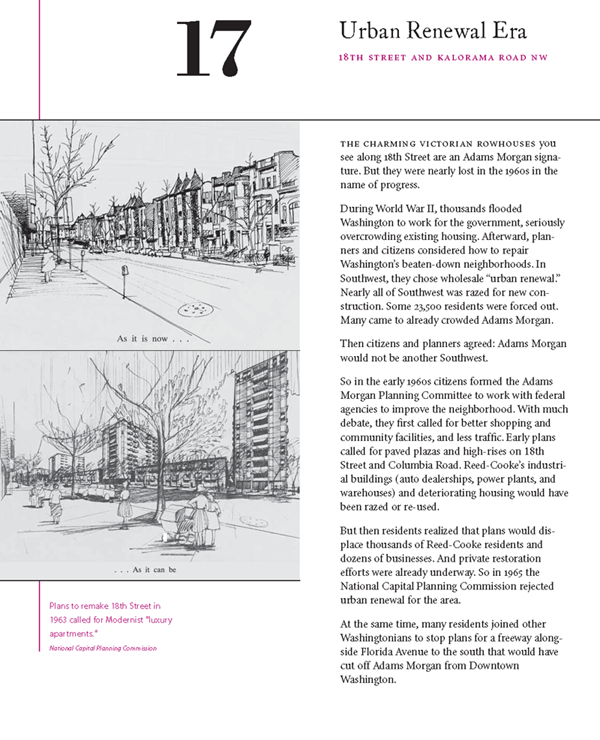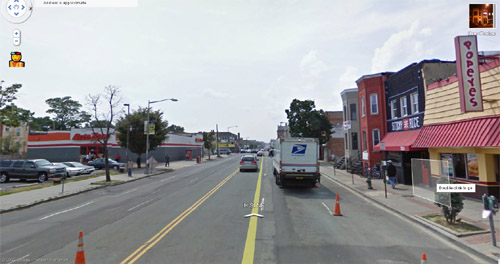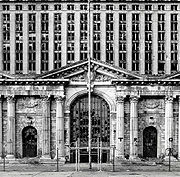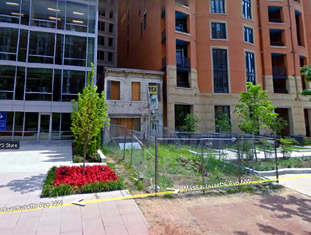|
Special Features





Image Libraries


|
|
Blog
|

Point of Rocks station |
Train stations are the perfect nexus of transit and architecture geekdom. Obviously, I love them. Since I also like to make lists, and since the DC area is fortunate enough to have several excellent examples of historic depots, here is a list of what I think are the best ones:
Number 10: Manassas
I’m a sucker for turrets and covered platforms, which help this otherwise unextraordinary station squeak in at number 10. Used by VRE and Amtrak.
Number 9: Chesapeake Beach
Click the link and look at the picture with the station all prettied up for Christmas. Isn’t that adorable? Too bad it’s no longer a functioning depot.
Number 8: Harpers Ferry
Solid all around, and it gets bonus points for being next to an awesome mountain tunnel. Used by MARC and Amtrak.
Number 7: Rockville
B&O Railroad architect Francis Baldwin designed a ton of great Victorian stations in Maryland. More will appear further down. Rockville’s is no longer in use as a depot.
Number 6: Fredericksburg
This big brick station is best remembered for its industrial looking covered platforms. We don’t have much of that steel look in DC, so it’s fun to find nearby. Used by Amtrak and VRE.
Number 5: Martinsburg
It used to be common for hotels and train stations to co-locate (especially out west). This is the only local example I know of. Used by Amtrak and MARC.
Number 4: Gaithersburg
Another of Francis Baldwin’s B&O depots, this one seems straight out of a fairy tale. Used by MARC.
Number 3: Frederick
This vintage 1854 building is reminiscent of Washington, DC’s old B&O station, which was demolished when Union Station was built. No longer in use as a depot.
Number 2: Point of Rocks
The best of Baldwin’s B&O stations, this one is just gorgeous. Used by MARC.
Number 1: Washington Union Station
Really, could there be any other answer?
Honorable Mentions: Fairfax Station, Laurel, Kensington (the latter two are Baldwin stations). Also note that I excluded the Baltimore area, which has a ton of good stations as well.
Average Rating: 4.5 out of 5 based on 166 user reviews.
October 5th, 2010 | Permalink
Tags: architecture, commuterrail, intercity, preservation, top10, transportation

|

This would not make Union Station better. |
Union Station’s Great Hall is one of the city’s most fantastic public spaces. It is beautiful, engaging, and lively. And somebody wants to tear a couple of giant holes in its floor.
Earlier this week, Washington City Paper reported on a proposal to cut holes in the Great Hall’s floor in order to provide better access to the basement food court, and to replace the Center Cafe with a new larger and more modern version.
Yes, holes in the floor. To access the food court.
Why, exactly? Nobody knows. It’s not like that food court is hurting for customers. On the contrary, it’s uncomfortably packed most of the day.
On the other hand, there are very good reasons why there should not be a couple of holes in the floor.
Most important, that such a successful public space should not be torn up on a whim. Union Station is the most visited destination in Washington. By any measure it is a place that is working tremendously well already, and if it ain’t broke, don’t fix it. Unnecessary changes that don’t benefit anything important threaten to make things worse rather than better.
Beyond that, there are good preservationist reasons not to change the Great Hall in this manner. The hall’s elegant classicism is fundamentally incompatible with a mundane food court. They’re both valuable and worthwhile spaces, of course, but making the Great Hall more like the food court inherently intrudes upon the elegance of the Great Hall.
Finally, there’s the small matter of this having been tried once before, and having failed miserably. In the late 1970s Congress spent more than $100 million on a pit in the middle of the Great Hall. It was so unpopular that it was filled in by the early 1980s. While that 1970s boondoggle is only barely comparable to the current proposal, it is nonetheless instructive: Turns out magnificent classical spaces are not appropriate places for large holes in the ground.
In the City Paper comments thread, some responders suggest that opposing changes to Union Station is just like opposing overhead streetcar wires. Nothing could be further from the truth. The streetcar plan promises to greatly benefit the city by virtue of better transportation and revitalized neighborhoods. This Union Station plan offers no such benefits, and as described above, it involves real risk. I oppose it for the same reason that I support streetcars: I want the city to be vital and prosperous. Streetcars would make Washington more so; ripping a couple of holes in one of the city’s best spaces wouldn’t.
At best, this proposal is a solution in search of an imaginary problem. Even if you think it’s harmless, it doesn’t solve anything that needs to be solved. At worst, it could ruin one of Washington’s most magnificent public gathering places.
Why take the risk?
 Cross-posted at Greater Greater Washington. Cross-posted at Greater Greater Washington.
 Cross-posted at the Washington Post Local Blogging Network. Cross-posted at the Washington Post Local Blogging Network.
Average Rating: 4.4 out of 5 based on 291 user reviews.
August 26th, 2010 | Permalink
Tags: development, fun, preservation

Given the post earlier this week about Washington’s unbuilt highways, I thought it would be interesting to republish this discussion of mid-century urban renewal from the Adams Morgan Heritage Trail Booklet. The booklet is available free to download from Cultural Tourism DC, and is similar to the historic marker on the sidewalk in Adams Morgan.
Click the image to download the booklet in pdf form.

Average Rating: 5 out of 5 based on 248 user reviews.
July 2nd, 2010 | Permalink
Tags: architecture, history, master planning, preservation, urbandesign

Today’s Washington Post features a cautionary tale of real estate greed, in which the owner of a Massachusetts Avenue building who wanted to cash in by selling to developers demanded such outrageous prices that the suitors dried up and built around him, rather than deal.
Yes that’s right, the greedy party in the story wasn’t the developer.
While I think the Post is right on in laying the blame for this missed opportunity at wealth on the feet of the building’s existing owner, whose poor treatment of the site makes it obvious he has no great love for the community (there’s no sidewalk out front, just a patch of dirt), the story also illustrates something extremely unfortunate about contemporary development.
No, I’m not talking about the fact that larger-scale redevelopment happens. This is Massachusetts-freaking-Avenue, right in downtown Washington; it is wholly appropriate that redevelopment happen here. Indeed, there is no better place.
Here is the bit of the story to which I object:
Jackson Prentice, a broker who on behalf of the Trammell Crow development company said … “Once they build around you, you’re done.”
…
Other developers say: The parcel, at nearly 1, 800 square feet, is too small to accommodate underground parking.
In other words, a perfectly good piece of downtown property is unusable because – the horror – it’s too small for its own parking garage.
Excuse me, but I know some developers who might disagree. If they can build a 42-story condo building in Toronto without a parking garage, then somebody can surely use a little lot in downtown Washington for something. Dedicated parking is not now and never was a necessary component of redevelopment. Some redevelopment needs it, sure, but not all redevelopment. In fact, the city of Washington is absolutely full of buildings that don’t have dedicated parking, not all of them from the 19th Century.
This lot sits at a fantastic location, directly fronting on one of downtown’s most important avenues. Yes, its owner was wrong to hold out for unreasonable amounts of money, and yes, it would have been more valuable as part of a larger redevelopment scenario, but considering this lot to be unusable because it’s small is just flat out wrong. We can build tall, narrow buildings in this city. Eventually, somebody will do that here.
Average Rating: 4.6 out of 5 based on 216 user reviews.
June 18th, 2010 | Permalink
Tags: development, preservation, urbandesign

The Washington Post yesterday featured an article discussing streetcar wires, and specifically the opposition to them from the (official) National Capital Planning Commission and (unofficial) Committee of 100.
Here is one of the views that the aforementioned groups want to protect so much that they rank it as a higher priority than improved urbanism, reduced congestion and pollution, economic development, access to jobs, and overall mobility:

Google Street View image of H Street, NE.
NCPC and the Cmt. of 100 think streetcars here will wreck the “beautiful character of the monumental core”. |
The position of NCPC and the Committee of 100 really is mind-boggling. Yes, there are some places where wires might be inappropriate, but this clearly isn’t one of them, so why oppose wires here? Do they think suburban-style auto repair and fast food shacks are beautiful? Is the strip-mall and asphalt character of suburban highways really their vision for what Washington’s central neighborhoods should be? The only other explanation for such dogmatic opposition to a plan that would help H Street redevelop into an actually beautiful urban place is mere kneejerk reactionism. When even sensible compromise solutions are disregarded, it raises the question of just what opponents are actually thinking.
Update: Tracktwentynine and IMGoph remind me via twitter that Georgetown is included in the wire ban, in addition to the L’Enfant city. Considering that one of DDOT’s proposed streetcar lines would run on K Street in Georgetown, this means NCPC and the Committee of 100 are opposed to streetcar wires underneath the elevated Whitehurst Freeway. They literally want to protect this view from streetcar wires:

Another important view plane that must be protected at all costs, according to people who expect to be taken seriously.
Google Street View image of K Street, NW. |
Average Rating: 4.5 out of 5 based on 208 user reviews.
April 6th, 2010 | Permalink
Tags: preservation, streetcar, transportation, urbandesign

Pardon this interruption to photo week, but for goodness sake, this is just ridiculous. Surface parking lots hurt the city. It is absolutely counter productive to planning goals in a Main Street environment to tear down a bunch of quality old row buildings and turn them in to a parking lot. And yet that’s what’s happening right now in our city, right in one of the places we hope to improve, no less. It is happening because there’s no way to stop it, ridiculous though it may be.
When our regulations make it this easy to do something this bad, our regulations have failed us. If there were ever an argument for removing “parking lot” from the list of by-right development types (scroll down to section 701.6.d), this is it.
H/T Avent.
Average Rating: 4.5 out of 5 based on 162 user reviews.
June 10th, 2009 | Permalink
Tags: development, preservation

|

Not worth saving |
GGW reports that Federal Judge James Robertson has made it clear that the congregation of the Third Church of Christ, Scientist at 16th and I Streets does have the right to tear down their hideous building, despite protests from the city’s historic preservation group. The decision makes demolition likely, which means one of downtown’s most important streets will no longer be tarnished by a massive hulk of brutalist ugly.
I agree with GGW commenter Cavan who says “I hope this case smacks some sense back into the preservationist community”. Preservation in America picked up steam when buildings like the Third Church were originally being built. One of the core values of the movement was stopping such buildings. Now that those buildings are old, the preservation movement can’t bring itself to admit that it was never about saving the *old*, so much as it was about saving the *good*.
Let’s get back to saving the good and let the mistakes of the past be erased.
Average Rating: 4.9 out of 5 based on 150 user reviews.
April 9th, 2009 | Permalink
Tags: architecture, preservation

|

Michigan Central Depot |
Train stations are my favorite kind of building, especially old ones. I love monumental civic architecture, and association with transit makes it all the better. Wherever I go I’m sure to check out the train station.
What a loss, then, that Detroit will soon tear down its once-magnificent main station. In virtually any other city in America this sort of thing stopped happening decades ago.
Average Rating: 5 out of 5 based on 152 user reviews.
April 7th, 2009 | Permalink
Tags: architecture, preservation

On Monday the DC Zoning Commission approved final plans for the long-awaited Convention Center Hotel. The new hotel will be at the corner of Massachusetts Avenue and 9th Street, NW, will have 1, 150 rooms, and will feature a domed atrium. Unlike some earlier plans, it will save the historic AFL Building (on the left in this photo), which will be used as a separate 42-room boutique hotel.
Saving the AFL building is especially good news considering the hotel would otherwise cover the entire block with what seems to be a supremely uninteresting glass curtain wall.

Raise your hand if “more curtain wall” is what you think downtown needs. Anybody?
Rendering courtesy Cooper Carry.
Average Rating: 4.7 out of 5 based on 267 user reviews.
November 26th, 2008 | Permalink
Tags: architecture, development, preservation, urbandesign

|

Should this be our future? There are good arguments for and against. |
As it seems to about once a year, the question of Washington’s height limit has once again come up. Should we keep it? Eliminate it? Raise it just a little? Is there a place in DC for what Federico García Lorca called both poetic and terrible? BeyondDC has opined already, but why not again?
Tall building pros:
- More density downtown, which helps Smart Growth, makes future investments in infrastructure more efficient by centralizing destinations, and increases the amount of retail that downtown can support.
- Downtown would transition from office-ghetto to mixed-use neighborhood. With the height limit restricting supply unnaturally, the overwhelming majority of buildable square footage downtown is used for office space since that’s what’s in highest demand. Residential is less profitable, so it is rarely built. Eliminating the height limit would allow the market to provide many more residential units downtown, turning it into more of a 24 hour environment.
- More tax revenue for the District (less for the suburbs).
Tall building cons:
- Washington’s skyline, currently unique among American cities, becomes less distinct.
- Downtown’s existing canopy of 12-story buildings will face tremendous and potentially wholesale pressure to redevelop. Right now downtown’s stock of buildings is architecturally diverse, since downtown has been constructed incrementally over the course of the last century or so. Architectural diversity is a good thing for a number of reasons, not the least of which are that pedestrians need diverse things to look at, and because diverse buildings breed diverse users, which breed a diverse economy. If the height limit is eliminated or raised there will be pressure to tear down existing buildings and replace them with taller new ones. Eliminate the height limit and pressure will mount to completely replace downtown’s core near Metro Center, home to the densest collection of old buildings, with new skyscrapers. Raise the height limit a few stories (but don’t eliminate it) and that pressure will extend to every building downtown, since property owners will seek to maximize leasable square footage. Any way you look at it, changing the height limit downtown will result in radical and large-scale changes to downtown’s existing building stock.
- There will be more surface parking lots. The big urban design benefit we get from the height limit is that it makes land a premium commodity, which makes it unprofitable to consume land for less-than-premium uses. New York aside, there is no American city with less land given over to parking than Washington. San Francisco, Chicago, Boston and Philadelphia all have large surface parking lots downtown, and all have many above-ground parking garages. Save some Federally-owned parking lots near the Capitol that aren’t subject to market pressures, downtown Washington has virtually no above-ground parking. The urban design benefits of that to pedestrians cannot be understated. If land is at less of a premium, then developers will have no reason to incur the added cost of putting parking underground, and land banking will become more common. Without a height limit, there is a very real chance downtown will start to look like this.
So what should we do? How can we obtain the benefits of added central city density, better neighborhoods, and more money without incurring the costs of homogeneity, wholesale redevelopment of historic buildings, and more land being used for urbanistically negative purposes?
The answer, to BeyondDC, seems obvious: Keep the height limit in the historic / monumental core, but lose it elsewhere in the District. Allow the likes of Tenleytown and Brookland to develop into true uptowns such as Bethesda and Silver Spring, and give Anacostia the chance to become the new Arlington. Doing so would protect the character of the L’Enfant city, and would at the same time extend efficient land use practices across the District. We’d get a more mixed-use and walkable city across the boards, without sacrificing any of the things that make Washington special, and without gambling downtown’s urbanity.
Average Rating: 4.8 out of 5 based on 190 user reviews.
October 14th, 2008 | Permalink
Tags: law, preservation, urbandesign

|
Media





Site
About BeyondDC
Archive 2003-06
Contact
Category Tags:
Partners
|
























